Spotlight on Travis Dove
May 18, 2012
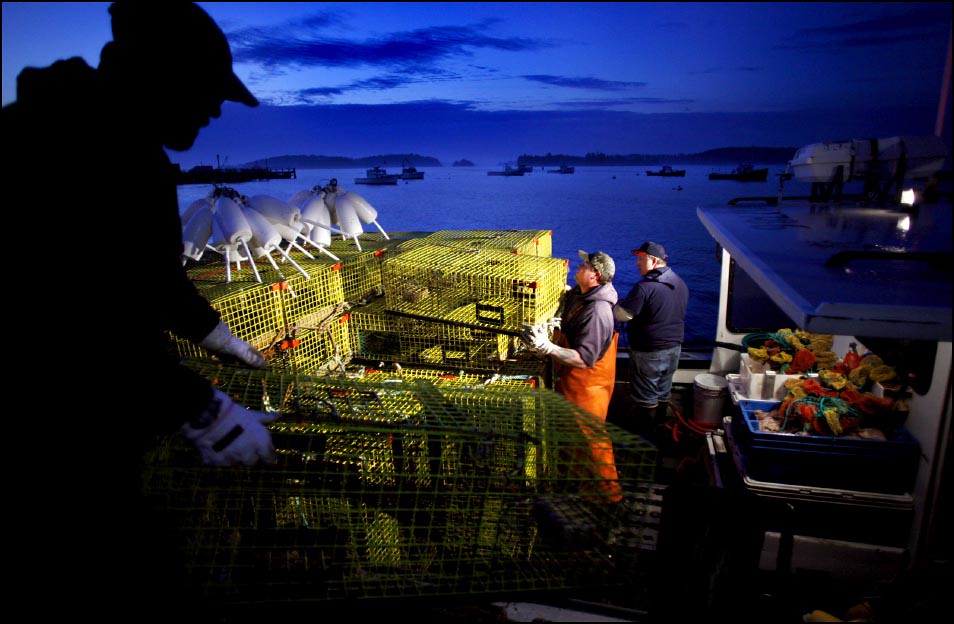
TID:
Thanks for taking part in TID. Can you tell us the backstory to this image?
TRAVIS:
First, thank you so much for asking me to be a part of this blog. It’s a great resource and I’m excited to be a part of it!
This is from a story about the sustainability of Maine's lobster fishing industry, assigned by the Virginia Quarterly Review. The writer and I decided to concentrate on Stonington, ME. Although Stonington is the largest lobster fishing port in a state, it still looks and feels like a pretty small town. There are only 1,200 residents and nearly 400 lobster boats. Regulations in Maine ensure that the individual operations remain small, so there are many multi-generational fishing families occupying the port rather than mammoth corporations. I wanted to talk about this photo in particular because it provides the sense-of-place that every story needs, without being a static landscape. Intimate moments are difficult to find, so it's easy to get caught up in that search and forget about providing the context for those images. I look at the sense-of-place pictures as the structure that everything else fits into. When I’m working on a new project, this is the type of image I try to find first.
TID:
What was going through your mind when you began the shoot?
TRAVIS:
I’m always nervous going into a new story, and I don’t relax until I’ve made at least one image that I like. I was fortunate to work with a great writer on this project, Jesse Dukes, who was eager to collaborate and it helped that he knew the area well. He flew in a couple days before me to lay the groundwork. After arriving in Stonington, I wanted to take a trip around the town. At that point I was just getting a feel for the place and scoping out locations where I could find a good view of the harbor and the town. First I drove, and then I walked around.
After that, my next priority was getting on a boat. Clearly those were going to be important images, and we figured out it was going to take a little effort to find someone willing to bring us along. Additionally, we knew we would have a limited number of days where the weather was “good” enough for the fishermen to go out.

Early on we ended up at a local resource center for fishermen, and one of Jesse’s interview subjects turned out to be the type of person who knows everyone in town. That’s exactly the person you want to meet when you’re in a new place. She was an excellent resource, and most of our initial contacts spawned from her, including the fishermen in this photograph.
TID:
What type of research and preparation did you do?
TRAVIS:
The first thing I did was read a few articles on the lobster industry that Jesse recommended and I tried to find a few on my own as well. When the story was initially proposed we didn’t even know what town(s) we would focus on. Because Jesse wanted to make sure this worked for both of us, I had an opportunity to give input on what areas would/wouldn’t work for pictures. I scoured the Internet for images of fishing towns based on a long list of possibilities Jesse provided. I always like to know what’s been done before, so I searched images on the wires, agencies, Flickr, etc.
Based on the pictures and information I found I pushed for Stonington. I could see that the harbor was filled with lobster boats, which was something I really needed in order to give the reader a sense of the scale of the lobster industry in Maine. That also meant there would be more activity and therefore more opportunity for pictures. Furthermore, it was clear from the pictures that the town had not been taken over by the tourist industry. It felt like a scenic, blue-collar town. It turned out that Jesse wanted to start there as well.
We initially planned on hitting another port halfway through our time, but because Stonington was a microcosm of the entire industry in Maine, we later decided it would be best to tell the entire story through their experience.
Before leaving for Maine I tried to map out the images I wanted to get for this story. I basically built the whole picture story in my head, based on what I had read and the pictures I had found. Of course, a lot of this stuff changed once I arrived, but it provided a place to start, and a way to judge how productive I needed to be each day.
TID:
You said you built the whole picture story in your head, which helped judge how productive you needed to be each day. Can you explain further what that process was like mentally?
TRAVIS:
This is something I started doing in graduate school after taking a photo essay class with Bruce Strong. He had each student create a “project roadmap” for his/her story.
The roadmap involves coming up with adjectives that relate to elements of your topic, and then thinking about the relevant, story-telling images that could convey the feeling of those adjectives. Using the adjectives forces you think about your story in more abstract and creative terms, rather than steps in a linear process. For example, I might look to make an image that says “back-breaking” rather than looking simply for a picture of lobstermen pulling up a trap. Even though I know in the back of my head that I need pictures of that specific activity, thinking of it in terms of capturing an adjective, steers me toward a more engaging image.
Bruce is fantastic at helping people approach and tell stories better. Anyone interested in learning more from the master should check out his storytelling workshop at Maine Media, or track him down at a photo seminar. He is a great teacher.
TID:
Can you walk us through your day and the moments before the main picture?
TRAVIS:
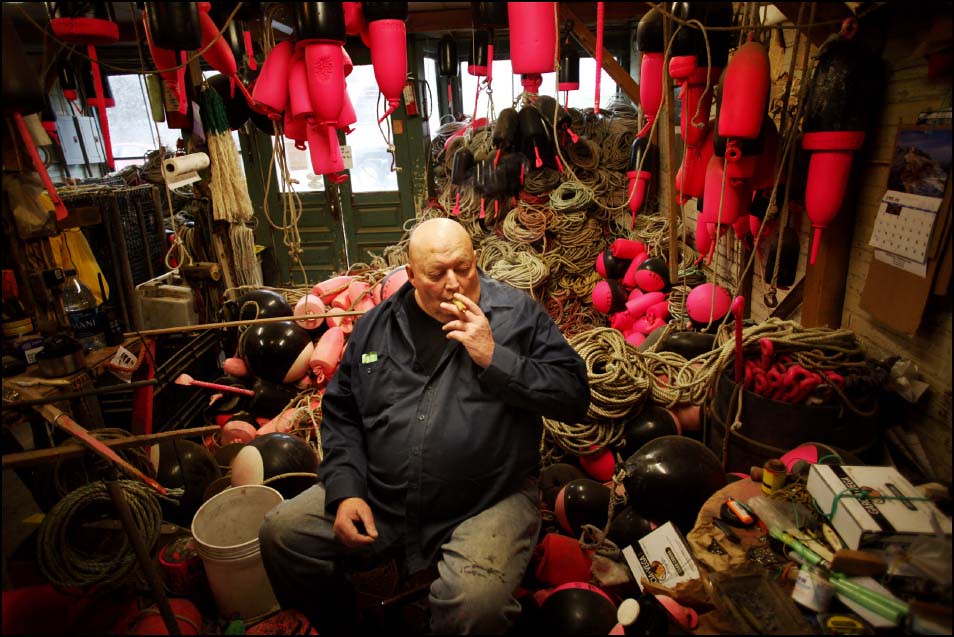
This was supposed to be our first day on the water and the fishermen we were going out with happened to be the first ones out of the harbor most mornings. So my day started at about 3 AM. I had everything packed in advance for a day on the boat. We knew there were rough seas coming, so we had only a 50/50 chance of going out. We spent a little time in the morning waiting by the dock with fishermen as they stood around a truck and decided whether or not they were going out.
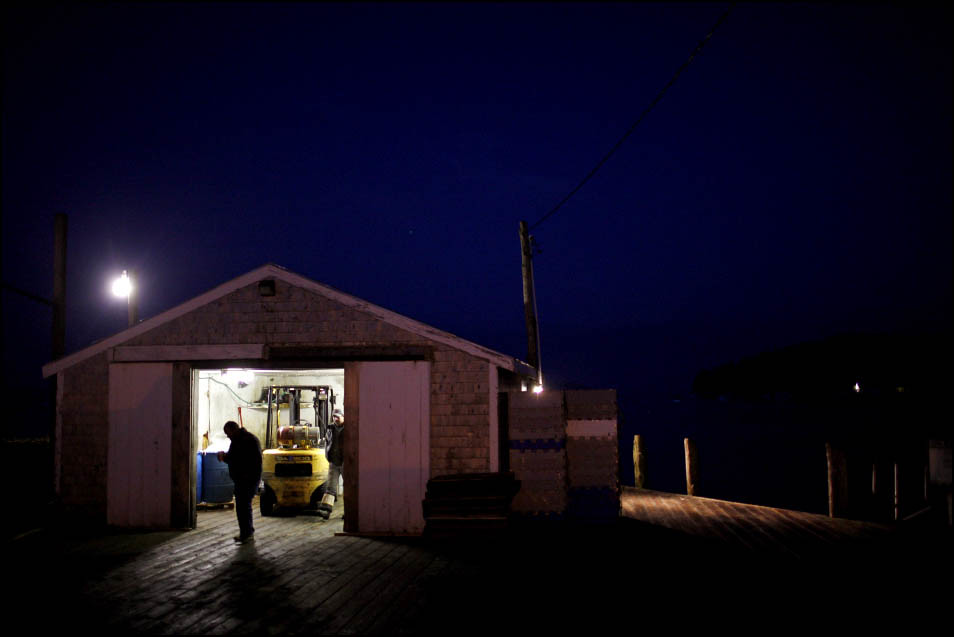
I shot a lot of pictures in the morning using just streetlights and boat lights. The light sucked (as did the pictures), but I knew it would get better soon, and I wanted to feel out a few different possibilities so I’d know where to be when daylight came. As soon as the sky started to brighten up, I began shooting spots where there was a good balance between the lights on the ground and the sky.
Once I made the frame I wanted, I hopped on the boat and we left the harbor. I got a quick tutorial on how not to die (don’t go anywhere near the moving ropes), and I began making pictures in the very cramped cabin. The boat pictures came easily in some ways but were difficult in others. They were easy in the sense that the fisherman completely ignored my presence once they began working, so any awkwardness caused by the camera disappeared in an instant.
They were difficult in the sense that I could barely keep my feet under me. To say the water was choppy would be an understatement. Half of my time was spent fighting vertigo and resisting the urge to vomit all over the deck. Most of the time though, these guys handled it as if the boat was standing on solid ground.
TID:
Now, onto the moment. Please describe what was happening at the time and what was going through your mind to make the image happen.
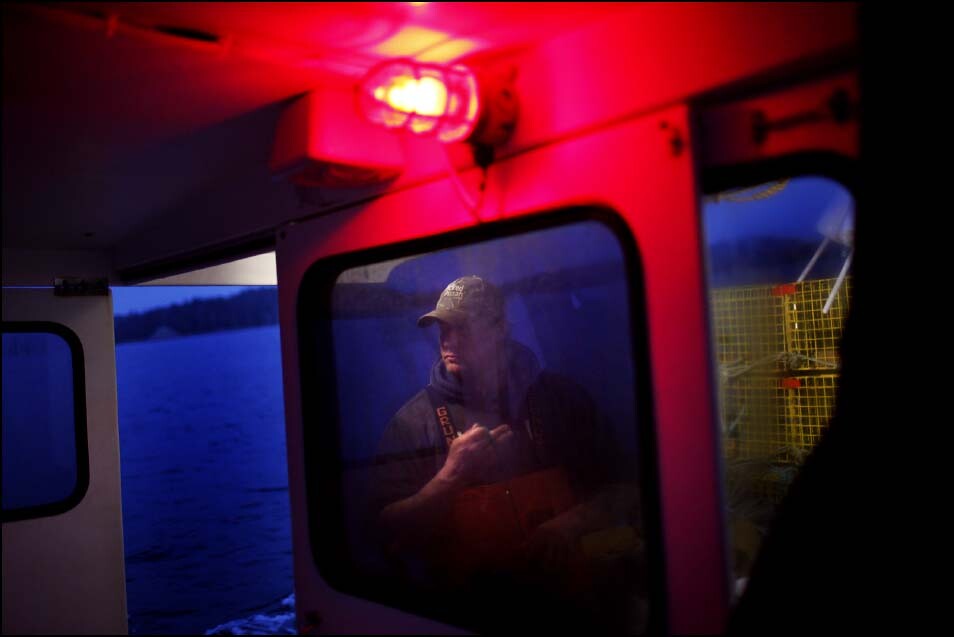
TRAVIS:
Our captain that day (who turned out to be a central figure in the story) decided he would go out despite the weather. In this image they are stacking their lobster traps on the boat. Had he not been delayed in the morning, he would have finished stacking traps in the dark. Luckily for me, they were still prepping when the light hit the right balance.
I work hard at creating engaging images that also provide a sense of place. In this instance I moved around a bit until I found a place where I could see both the harbor and the layers of activity. I could see things had potential to line up cleanly, but it took a moment to find the right spot. Once I found the right angle the stage was set, and it was just a matter of waiting for people to land in the right spaces.
Looking through the contact sheet, it appears that they were just walking around, but actually they were moving very quickly. Time is money when that boat is running, so they do not waste a second. I wanted the silhouette on the left to fill the left side of the frame and help hold your eye on the activity in the center. I only caught a few frames where his silhouette was clean and well framed above the horizon. Of those, there was really only one where the fishermen were simultaneously standing in the light.
I didn’t have time to check if I had gotten the picture until we were motoring out. When I saw this one I finally took a breath and relaxed a bit. It was the first picture from Stonington that I really liked, and it eventually appeared as a double truck in the magazine to open the story.
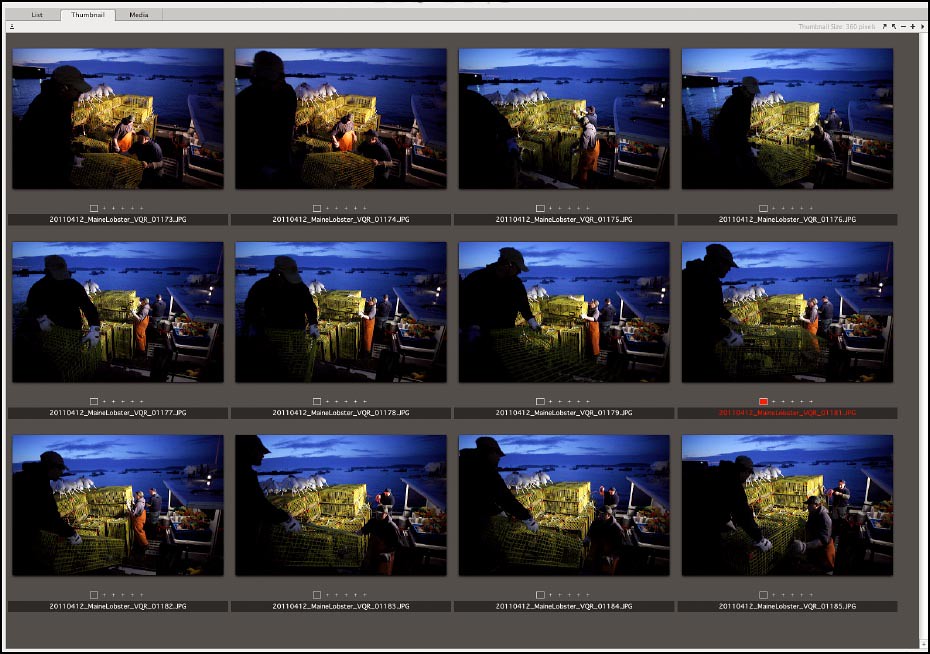
TID:
What did you learn about yourself during this project?
TRAVIS:
I did a good bit of work leading up to this story, and I worked double overtime when I got there, but some of these lobstermen made me feel like I could push myself harder. The labor is absolutely back-breaking, yet I know of at least one who is still doing it full-throttle into his eighties. Sometimes I think my job is tough, until a story like this provides some much needed perspective. It’s a good kick in the ass.
TID:
What surprised you?
TRAVIS:
More than anything I was surprised by how quickly the time flew. I left just as I felt like I was settling in. That’s one reason mapping out a daily plan was so important…there was always something I could be working on, so I had no excuses to waste time.

TID:
In conclusion, what advice do you have for photographers in similar situations?
TRAVIS:
Take your time and make thoughtful images. I’ve found I make better pictures when I take just a moment to compose myself and the picture. When something visually interesting is unfolding in front of you, it’s almost natural to start shooting like mad to catch it.
::BIO:::
Travis Dove is a freelance editorial photographer and native North Carolinian. He attended graduate school at Ohio University’s School of Visual Communication where he studied photography and met many lasting friends.
Travis was drawn to photojournalism for the range of experiences the profession offers. He has photographed hermitic Greek monks for National Geographic, anarchist skateboarders for Rolling Stone, and presidential candidates for The New York Times. A second-generation graduate of Wake Forest University, he passionately follows Demon Deacon sports in his down time while providing biased and unsolicited commentary to anyone within earshot. He currently lives in Carrboro, NC with his wife, Kerry, a Duke fan, and their dog, Chiclet, whose allegiances are unknown.
Next week we'll take a look at this wonderful picture by Alyssa Schukar:

If you have any suggestions or if you want to interview someone for the blog, contact Ross Taylor or Logan Mock-Bunting.